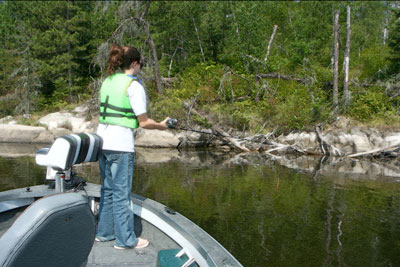Getting Kids Started: It’s about Them and Their Fishing
To Jason Mitchell, introducing kids to fishing and hooking them on the sport ideally takes place on the same day. It’s a specialty that takes a commitment from an adult that goes beyond “letting ‘em come along.” Mitchell is a veteran guide from Devils Lake, North Dakota, who travels widely to fish and film Jason Mitchell Outdoors television. Still a relatively young man himself, he has a huge soft spot in his heart for helping youngsters become attached to angling–including his own kids, Olivia and Brennen.
To Jason Mitchell, introducing kids to fishing and hooking them on the sport ideally takes place on the same day. It’s a specialty that takes a commitment from an adult that goes beyond “letting ‘em come along.”
Mitchell is a veteran guide from Devils Lake, North Dakota, who travels widely to fish and film Jason Mitchell Outdoors television. Still a relatively young man himself, he has a huge soft spot in his heart for helping youngsters become attached to angling–including his own kids, Olivia and Brennen.
“It has to be about the kids and their fishing,” begins Jason. “Your child-to-adult ratio has to be low. You can’t expect to take out more than two kids, and it’s best if it’s one-on-one.
“And you have to be in a good spot. It doesn’t have to be a fly-in trip; it can just be a good spot off a dock, or the best bullhead spot in the area. As long as you can provide something with fins, some action, you’re off to a good start.”
 Kids Own the Day
Kids Own the Day
While guiding, Jason has seen firsthand what happens when parents want their kids to pursue big walleyes rather than the faster action of smaller walleyes, or better yet, panfish.
“If parents put their own desires in front of the kids’, it’s usually a disaster,” he says. “Don’t go out there to impress these kids with your advanced abilities. Have their first trips be something simple they can grasp. Something where they can have success.
“Try to find a situation where it’s easy, in a sense. Take them to a place where they can cast and not get into trouble, but let them make mistakes without criticizing their technique. When you take a youngster fishing, that day is their day. You’re fishing for whatever bites. And you stop when they want to, even if it’s after just an hour. Kids don’t have the threshold to stay out all day, even if it’s a nice day.”
After an outing or two, if a youngster is taking to the sport, then it can be time to broaden their horizons–but keep the training wheels on.
“You can take them out trolling crankbaits, or bottom bouncers, or jigging,” says Jason, “but it might take you to detect the bites in those situations. As soon as you set the hook, hand them the rod. At the end of the trip, they don’t remember you had anything to do with it. They tell their friends how many fish they caught.”
Let ‘em Bring Toys
On a youngster’s first fishing excursion, it’s common for them to want to bring a gaming device or other toys. Rather than separating them from these security blankets, Jason urges adults to “not ban toys right off the bat.”
From his guiding experience, Jason has seen that it almost always works better to let kids bring toys, and play with them.
“I don’t think it’s a big deal if they want to bring some toys from home,” he says, “if it eases the transition between living room and the outdoors. A lot of times, the Game Boy is in the glove box by the end of the day, and they aren’t paying attention to it anymore.”
Let ‘em Keep Some Fish
Some kids naturally want to let every fish go, some kids want to keep ‘em all, and some kids want to keep one or two.
As long as the fish are of legal size and limits are adhered to, “I think kids should be able to keep some fish,” says Jason, “and we shouldn’t judge the kids for which fish they choose to keep. If they spend the rest of the day with the livewell open, looking at the fish, and then we fillet them and eat them, that’s all good stuff.”
Let Friends Come Along
While he feels that initial outings are best handled one-on-one, after kids have a good introduction to fishing, bringing a friend or two can help kids have fun on the water.
“Especially once they get a little older,” says Mitchell, “maybe fourth or fifth grade, let some friends come along. Then it’s really cool. They love to do things with their friends. It’s a good way to get their friends outside, too. Maybe all of them will like fishing, and it will become something they do together for many years.”
Mentors are the True Key
Jason, who is also a volunteer instructor for the nonprofit School of Outdoor Sports, believes that the key to developing lifelong anglers is to provide them with quality mentoring.
“Teaching kids to fish requires a commitment of time from people who are willing to put their own fishing on hold,” he says. “You have to get kids on the water several times before they can get a feel for it, have some success, get that feeling of accomplishment that makes fishing so important and special.
“It’s so important that they catch something. Those are the life-changing events. If they catch fish, that’s what they associate fishing with, rather than being cold or hot or getting sunburned. It comes down to you taking one kid to your best spot and letting them catch–or at least reel in–all the fish. If everybody did that once a year, we’d have a lot more new anglers.”
Notes: Jason Mitchell’s time on the water is difficult to match. He earned a renown reputation as a guide on North Dakota’s Devils Lake and now hosts Jason Mitchell Outdoors television, airing 9 a.m. Sundays on Fox Sports North and Fox Sports Midwest. www.jasonmitchelloutdoors.com.





